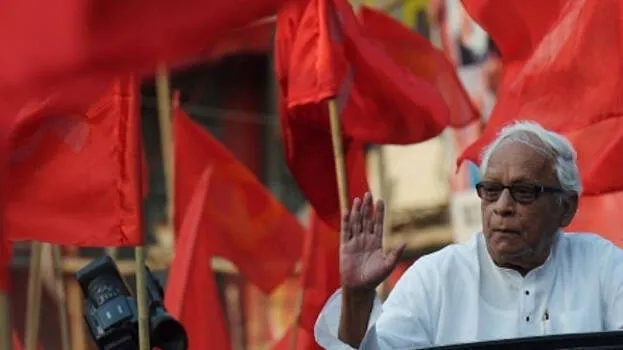

KOLKATA: It was no coup but years of turmoil and struggles that helped Bengal inculcate the ideology of CPM. The party represented the marginal section and the farmers which helped the reign continue for a historic 34 years.
Jyoti Basu resigned as Chief Minister of West Bengal on October 28, 2000, and the sceptre was passed to Buddhadeb Bhattacharjee. In the 2004 Lok Sabha elections, the Left won emphatically and the credit fell upon Buddhadeb’s no corruption, unsullied image and popularity in West Bengal.
Left Front won 35 out of 42 constituencies in West Bengal. While the Indian National Congress won six seats, the Trinamool Congress had to settle for just one seat with the sole winner being the current CM Mamata Banerjee. The Left Front won again in the assembly elections held in April-May 2006. The Left Front won 196 seats in the 294-member Bengal Legislative Assembly. CPM alone managed to win 143 members.
It was during this time of unbridled rule that Bhattacharjee felt the need to adopt an industry-friendly approach. Ratan Tata was looking for a place to start a Nano car factory in West Bengal and zeroed Singur in the Hooghly district.
Singur is the most fertile region in the state and the government acquired 997 acres of land for the car factory much to the chagrin of the farming community. The farmers protested when Bhattacharjee’s government attempted to acquire the property under the Land Acquisition Act 1894. The government offered huge compensation but they did not budge. Political parties like Trinamool Congress and SUCI and various Maoist groups coalesced in support of the famers, kick starting a strong agitation.
Despite many farmers being CPM loyalists, the government turned a blind eye and went with the acquisition. Mamata Banerjee started an indefinite hunger strike on December 4, declaring her support for the Singur strike. By December 27, Mamata faced death after her condition worsened and even doctors feared that she would die anytime. With persuasion from President APJ Abdul Kalam, Mamata Banerjee ended her fast at midnight on December 29.
The Singur protest shook the core of communism in Bengal altogether while effigies of Mamata started appearing across the state. On 21 January 2007, the construction of the car factory at Singur was formally started, but Tata could not make much progress.
On October 3, 2008, Ratan Tata announced his decision to withdraw from the Singur project and blamed the negative attitude espoused by Mamta Banerjee. Tata moved their factory to Gujarat after CM Narendra Modi rolled the red carpet for the business tycoon.
If Singur was a trailer, then Nandigram would be the real movie which settled the fate of the left-front government in West Bengal. 10,000 acres of land was required to create a special economic zone and set up a chemical factory for Indonesia's Salim Group. To clamp down on the farmer’s protest, police opened fire killing 14 and injuring 70 people. CPM workers aided the police which aggravated the tensions.
Farmers ran for their lives from Nandigram to other places. Bhumi Uchhed Pratirodh Committee with support from Trinamool Congress, SUCI and Maoist groups resisted the violence. Writers and filmmakers like Medha Patkar, Anuradha Talwar, Arundhati Roy, Mahasweta Devi, Aparna Sen and Sunil Gangopadhyay have declared their support for the Nandigram movement putting the left government in a dock.
Even Jyothi Basu blamed the police action in Nandigram as unfortunate. Following this, land acquisition was stopped and farmers returned to Nandigram. But in November 2007 and May 2008, clashes erupted again. In an ensuing clash with CPM workers, many farmers were killed and unrest followed. The real setback for the government happened in the May 2008 elections to the East Midnapore Zilla Parishad, where the left front lost its majority.
In the 2009 LS elections, left only managed paltry few seats in the western belt of Bengal. The Trinamool-Congress alliance won all the areas adjacent to Bangladesh, massively becoming popular among the Muslim sections of the borderland and thus starting a new era of vote polarization. The Nandigram protest made the Muslim voters change their stance and move towards TMC. The 2011 assembly elections became a waterloo for the Left Front. Trinamool Congress won 184 seats with ally Congress winning 42 seats. The Left Front was limited to just 62 seats.
In 2011, Mamata Banerjee annulled the deal made with Tata in Singur and won the case in the Supreme Court. She also made an impactful decision to return the acquired lands to the farmer community. The single decision prepared the coffin for the left party in Bengal and the final nail in the coffin came during late 2018 when the third alternative BJP emerged as a popular player in Bengal politics. Red flags paved the way for orange and were pushed into the abyss of redundancy by the people of Bengal since then.